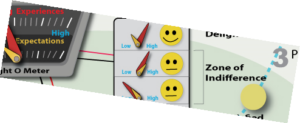 It turns out that the world has been swimming in positive psychology for a couple of decades. Amid that, we have many things to cite in the world that aren’t so swimmingly positive. And how many of us have fallen prey to the motivating seminar or sales pitch, only to fail later when we return to our old habits and practices. Being positive, having unabated enthusiasm, and putting blinders up to all things negative, doesn’t create the warm, fuzzy, prosperous future we once thought it would.
It turns out that the world has been swimming in positive psychology for a couple of decades. Amid that, we have many things to cite in the world that aren’t so swimmingly positive. And how many of us have fallen prey to the motivating seminar or sales pitch, only to fail later when we return to our old habits and practices. Being positive, having unabated enthusiasm, and putting blinders up to all things negative, doesn’t create the warm, fuzzy, prosperous future we once thought it would.
In the December issue of Psychology Today, Annie Murphy Paul, explores the uses and abuses of optimism (and pessimism). Like the author of the article suggests, as in many things, context matters. It turns out that there is a time to be optimistic and a time to be pessimistic. Sometimes it is helpful to think of things that might go wrong.
 We find this especially interesting given our work with teams using the Big Idea Toolkit. It turns out people adopt two distinct psychological zones or mindsets, when using the toolkit. There is the PlayGround, rife with positive psychology. This is where we encourage people to think about the unbounded possibilities and untapped potential. Here we want unbridled enthusiasm and expansive thinking. One of the guiding principles for the PlayGround is “Ideas are not judged here.” While we do tout the PlayGround as the place where ideas live, those ideas won’t make it in the real world until somebody focuses and gets something done.
We find this especially interesting given our work with teams using the Big Idea Toolkit. It turns out people adopt two distinct psychological zones or mindsets, when using the toolkit. There is the PlayGround, rife with positive psychology. This is where we encourage people to think about the unbounded possibilities and untapped potential. Here we want unbridled enthusiasm and expansive thinking. One of the guiding principles for the PlayGround is “Ideas are not judged here.” While we do tout the PlayGround as the place where ideas live, those ideas won’t make it in the real world until somebody focuses and gets something done.
For that, you need execution and the place where execution lives, the PlayBook, another component of the Big Idea Toolkit (or your innovation culture). In the PlayBook, a healthy dose of pessimism is welcome. Here you need to be mindful of deadlines, deliverables, actions, and owners. It might be construed as negative, but guess what – that negative energy brings focus, just what you need to ensure your execution wheels stay on the tracks.
 This isn’t a new idea; the ancient Chinese subscribed to a concept called Yin Yang, the belief that there exists two complementary forces in the universe. One is Yang which represents everything positive or masculine and the other is Yin which is characterized as negative or feminine. One is not better than the other. Instead they are both necessary and a balance of both is highly desirable. We live in a world that needs a balance of both positive and negative, because that is the real world.
This isn’t a new idea; the ancient Chinese subscribed to a concept called Yin Yang, the belief that there exists two complementary forces in the universe. One is Yang which represents everything positive or masculine and the other is Yin which is characterized as negative or feminine. One is not better than the other. Instead they are both necessary and a balance of both is highly desirable. We live in a world that needs a balance of both positive and negative, because that is the real world.
Was it all Pollyanna thinking at Bank of America when executives there rolled out the plan to charge customers $5 a month for debit card transactions? Consumers roiled by this decision arrived on the doorsteps of credit unions in droves. On the backs of this, Verizon quickly followed with a decision to charge customers $2 per month to pay their Verizon bill online or over the phone. In all of their positive thinking, perhaps they thought they were granted immunity from similar customer backlash. A healthy dose of “What Could Really Go Wrong Here” is sometimes the best conversation.
If after you are reading this article and you are still thinking positively, think about how optimistic you would be if you encountered a Kodiak bear while on a hike? Or were faced with the challenge of launching a space shuttle or mega store or latest tablet computer or asked to change your pricing plan or add charges to your loyal customers. Remember, context matters.
If you might get eaten, accidentally kill others, lose investors money, go out of business, tarnish a longstanding company reputation or alienate your best customers, then you might want to employ a bit of healthy skepticism in your planning, execution, and most importantly in your conversations. Many organizations that are no longer around probably wish they had.
If you don’t switch up your mindset from time to time, matching optimism or pessimism to suit the context, then you might just NetFlix your customers and BlockBuster yourself out of business.
Like Annie stated in her article, if the father of positive psychology, Martin Seligman, is rethinking the role of optimism in our lives then perhaps you should too!
Like this post? Consider sharing it with others and also subscribing to receive new articles as they happen.
about the author
Gregory Olson is a consultant, speaker, and author of The Experience Design BLUEPRINT: Recipes for Creating Happier Customers and Healthier Organizations.
His latest book project is “L’ impossi preneurs: A Hopeful Journey Through Tomorrow.” It is a celebration of impossipreneurs of the past and an exploration of today’s “impossible” ideas. Stay tuned to learn more by subscribing to this blog or connecting with Greg on LinkedIn.![]()
Chapters in “The Experience Design Blueprint” that especially pertain to this article include:
- Chapter 12: The Three Psychological Zones
- Chapter 13: Taking Flight
See a book summary. Read the book reviews on Amazon. Read The Experience Design Blueprint on Kindle or any device using the free Kindle Reader application or read the full color print edition. Already read it? Please connect and let me know.








